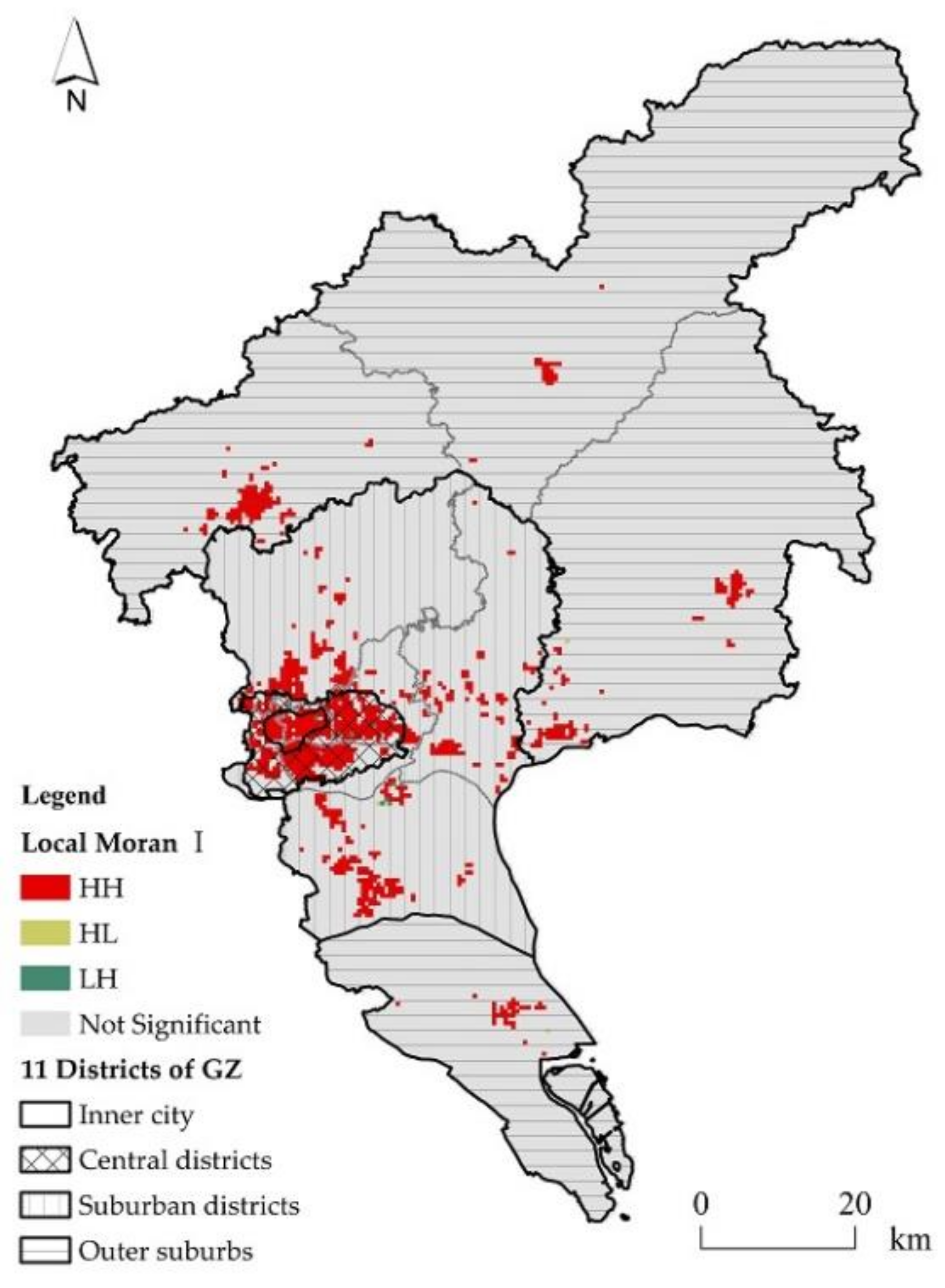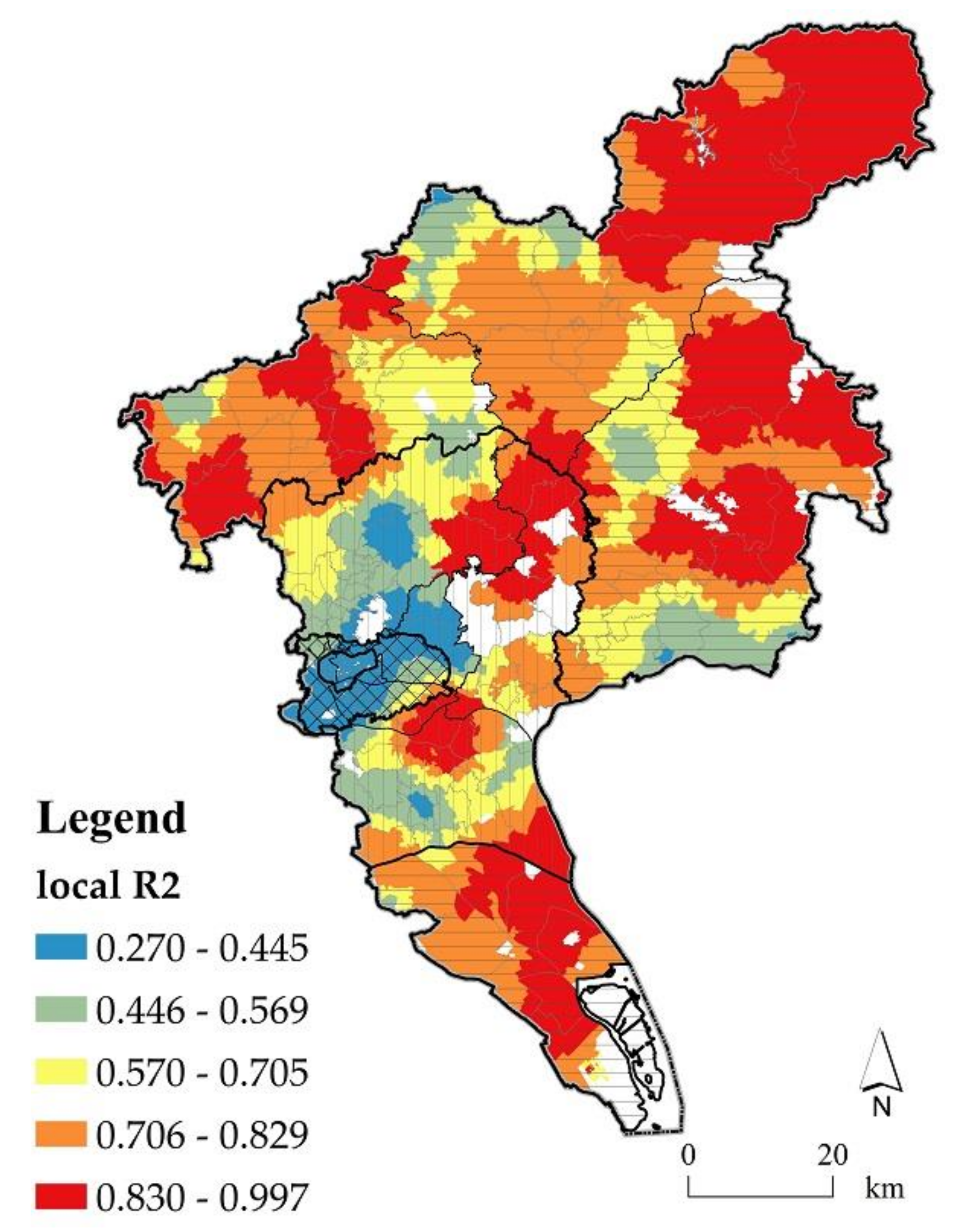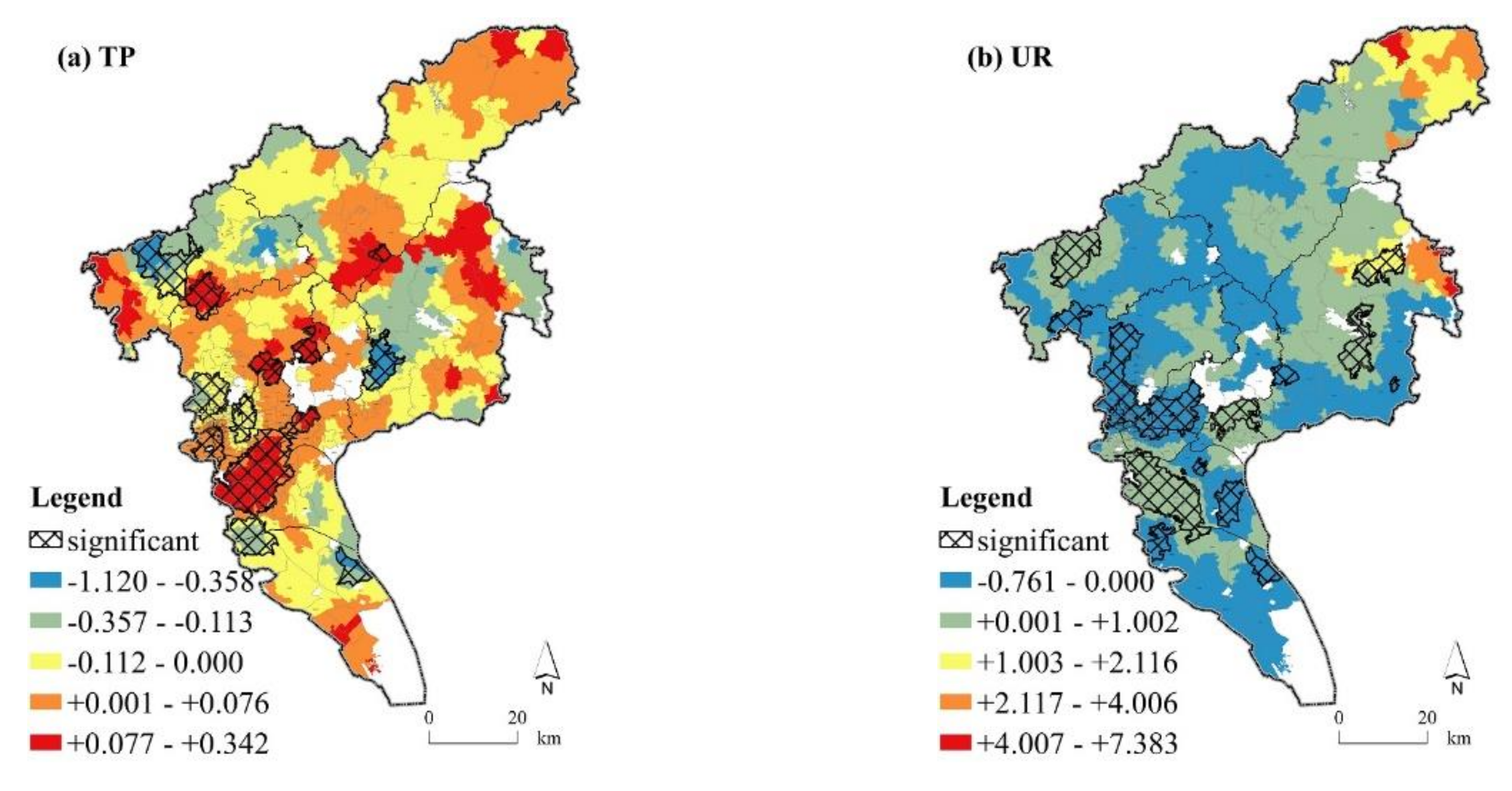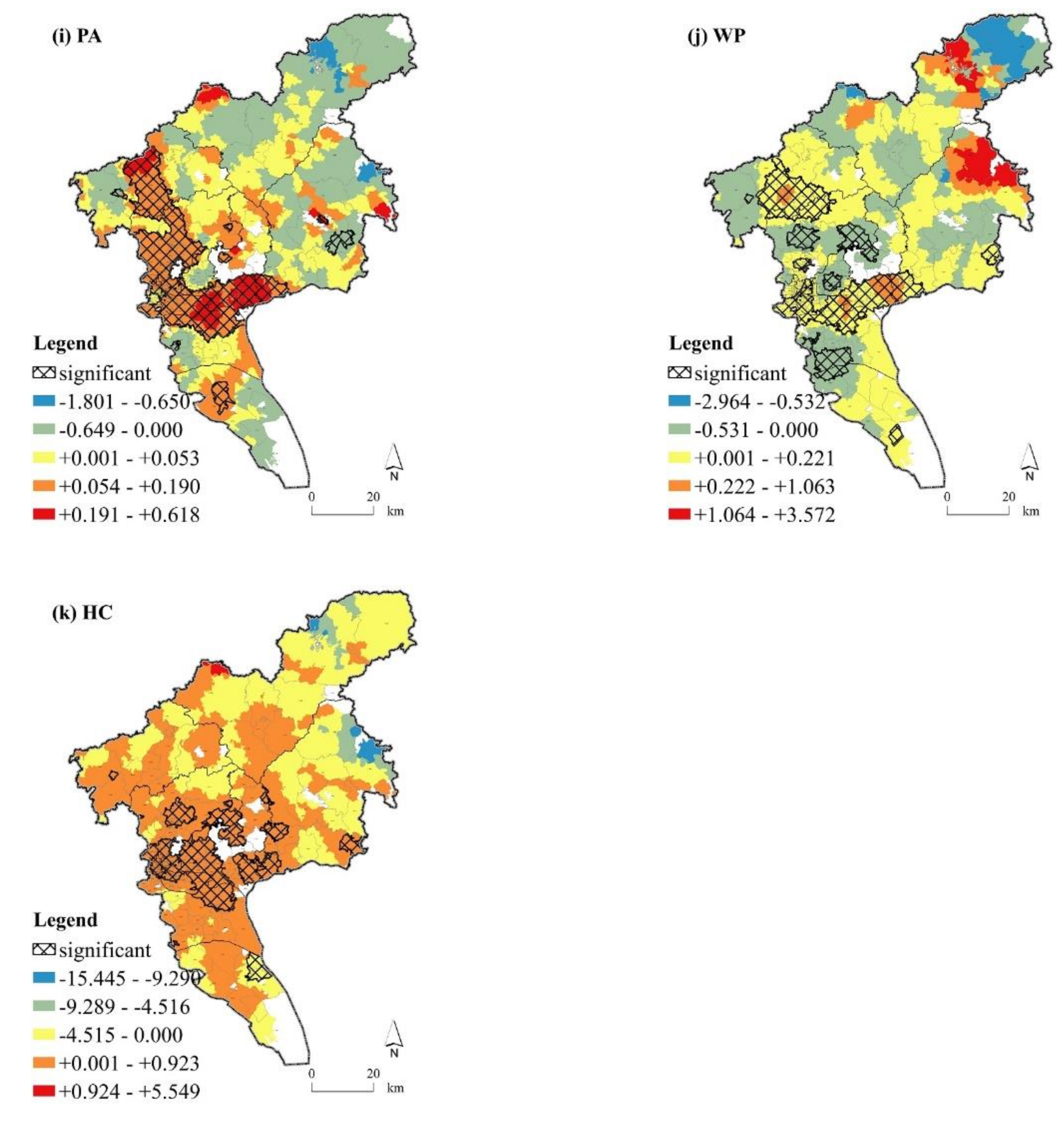Heterogeneity of Spatial Distribution and Factors Influencing Unattended Locker Points in Guangzhou, China: The Case of Hive Box
Abstract
:1. Introduction
2. Literature Review
3. Materials and Methods
3.1. Study Area
3.2. Data Source
3.3. Methodology
3.3.1. Kernel Density Estimation Method
3.3.2. Spatial Autocorrelation Analysis Model
3.3.3. Geographical Weighted Regression Model (GWR)
4. Results
4.1. Results for Kernel Density Estimation
4.2. Results for Global Moran’s I Index and Anselin Local Moran’s I Index
4.3. Results for Influencing Factors of Geographical Weighted Regression Model
4.3.1. Spatial Spillover Effects of Influencing Factors
4.3.2. Geographical Variations of Influencing Factors
5. Discussion
6. Conclusions
Author Contributions
Funding
Data Availability Statement
Conflicts of Interest
References
- Xiao, Z.; Wang, J.J.; Lenzer, J.; Sun, Y. Understanding the diversity of final delivery solutions for online retailing: A case of Shenzhen, China. Transp. Res. Procedia 2017, 25, 985–998. [Google Scholar] [CrossRef]
- Kedia, A.; Kusumastuti, D.; Nicholson, A. Acceptability of collection and delivery points from consumers’ perspective: A qualitative case study of Christchurch city. Case Stud. Transp. Policy 2017, 5, 587–595. [Google Scholar] [CrossRef]
- Morganti, E.; Dablanc, L.; Fortin, F. Final deliveries for online shopping: The deployment of pickup point networks in urban and suburban areas. Res. Transp. Bus. Manag. 2014, 11, 23–31. [Google Scholar] [CrossRef] [Green Version]
- Intelligent Service Solutions by HIVE BOX. Available online: https://www.fcbox.com/en/pc/index.html#/ (accessed on 11 June 2021).
- General Office of the State Council, PRC. 2018. Available online: http://www.gov.cn/zhengce/content/2018-01/23/content_5259695.htm (accessed on 12 May 2021).
- State Post Bureau, PRC. 2017. Available online: http://www.spb.gov.cn/zc/ghjbz_1/201702/t20170213_991162.html (accessed on 7 March 2021).
- Xue, S.; Li, G.; Yang, L.; Liu, L.; Nie, Q.; Muhammad, S.M. Spatial pattern and influencing factor analysis of attended collection and delivery points in Changsha city, China. Chin. Geogr. Sci. 2019, 29, 1078–1094. [Google Scholar] [CrossRef] [Green Version]
- Baidi, M.M.; Manerba, D.; Perboli, G.; Tadei, R. A generalized bin packing problem for parcel delivery in last-mile logistics. Eur. J. Oper. Res. 2019, 274, 990–999. [Google Scholar] [CrossRef]
- Florio, A.M.; Feillet, D.; Hartl, R.F. The delivery problem: Optimizing hit rates in e-commerce deliveries. Transp. Res. Part B Methodol. 2018, 117, 455–472. [Google Scholar] [CrossRef]
- Andriankaja, D. The Location of Parcel Service Terminals: Links with the Locations of Clients. Procedia Soc. Behav. Sci. 2012, 39, 677–686. [Google Scholar] [CrossRef] [Green Version]
- Cardenas, I.D.; Beckers, J. A location analysis of pick-up points networks in antwerp, Belgium. Int. J. Transp. Econ. 2018, 45, 557–569. [Google Scholar] [CrossRef]
- Leonardi, J.; Browne, M.; Allen, J.; Bohne, S.; Ruesch, M. Best Practice Factory for Freight Transport in Europe: Demonstrating how ‘Good’ Urban Freight Cases are Improving Business Profit and Public Sectors Benefits. Procedia Soc. Behav. Sci. 2014, 125, 84–98. [Google Scholar] [CrossRef] [Green Version]
- Manerba, D.; Mansini, R.; Zanotti, R. Attended home delivery: Reducing last-mile environmental impact by changing customer habits. IFAC PapersOnLine 2018, 51, 55–60. [Google Scholar] [CrossRef]
- Ghajargar, M.; Zenezini, G.; Montanaro, T. Home delivery services: Innovations and emerging needs. IFAC PapersOnLine 2016, 49, 1371–1376. [Google Scholar] [CrossRef] [Green Version]
- Orenstein, I.; Raviv, T.; Sadan, E. Flexible parcel delivery to automated parcel lockers: Models, solution methods and analysis. EURO J. Transp. Logist. 2019, 8, 683–711. [Google Scholar] [CrossRef]
- Dell’Amico, M.; Hadjidimitriou, S. Innovative Logistics Model and Containers Solution for Efficient Last Mile Delivery. Procedia Soc. Behav. Sci. 2012, 48, 1505–1514. [Google Scholar] [CrossRef] [Green Version]
- Song, L.; Cherrett, T.; McLeod, F.; Guan, W. Addressing the last mile problem: Transport impacts of collection and delivery points. Transp. Res. Rec. 2009, 2097, 9–18. [Google Scholar] [CrossRef] [Green Version]
- Schwerdfeger, S.; Boysen, N. Optimizing the changing locations of mobile parcel lockers in last-mile distribution. Eur. J. Oper. Res. 2020, 285, 1077–1094. [Google Scholar] [CrossRef]
- Lee, H.; Chen, M.; Pham, H.T.; Choo, S. Development of a decision making system for installing unmanned parcel lockers: Focusing on residential complexes in Korea. KSCE J. Civ. Eng. 2019, 23, 2713–2722. [Google Scholar] [CrossRef]
- Lachapelle, U.; Burke, M.; Brotherton, A.; Leung, A. Parcel locker systems in a car dominant city: Location, characterization and potential impacts on city planning and consumer travel access. J. Transp. Geogr. 2018, 71, 1–14. [Google Scholar] [CrossRef]
- Rolko, K.; Friedrich, H. Locations of Logistics Service Providers in Germany—The basis for a new freight transport generation model. Transp. Res. Procedia 2017, 25, 1061–1074. [Google Scholar] [CrossRef]
- Heitz, A.; Dablanc, L. Logistics spatial patterns in Paris: Rise of Paris Basin as logistics megaregion. Transp. Res. Rec. 2015, 2477, 76–84. [Google Scholar] [CrossRef]
- Heitz, A.; Beziat, A. The Parcel Industry in the Spatial Organization of Logistics Activities in the Paris Region: Inherited Spatial Patterns and Innovations in Urban Logistics Systems. Transp. Res. Procedia 2016, 12, 812–824. [Google Scholar] [CrossRef] [Green Version]
- Zheng, Z.; Morimoto, T.; Murayama, Y. Optimal location analysis of delivery parcel-pickup points using AHP and network huff model: A case study of shiweitang sub-district in Guangzhou city, China. ISPRS Int. Geo Inf. 2020, 9, 193. [Google Scholar] [CrossRef] [Green Version]
- de Oliveira, L.K.; de Oliveira, R.L.M.; de Sousa, L.T.M.; Caliari, I.D.P.; Nascimento, C.D.O.L. Analysis of accessibility from collection and delivery points: Towards the sustainability of the e-commerce delivery. Urbe. Rev. Bras. Gest. Urbana 2019, 11, 20190048. [Google Scholar] [CrossRef] [Green Version]
- Zhou, M.; Zhao, L.; Kong, N.; Campy, K.S.; Xu, G.; Zhu, G.; Cao, X.; Wang, S. Understanding consumers’ behavior to adopt self-service parcel services for last-mile delivery. J. Retail. Consum. Serv. 2020, 52, 101911. [Google Scholar] [CrossRef]
- Wang, X.; Yuen, K.F.; Wong, Y.D.; Teo, C.C. An innovation diffusion perspective of e-consumers’ initial adoption of self-collection service via automated parcel station. Int. J. Logist. Manag. 2018, 29, 237–260. [Google Scholar] [CrossRef]
- Yuen, K.F.; Wang, X.; Ng, L.T.W.; Wong, Y.D. An investigation of customers’ intention to use self-collection services for last-mile delivery. Transp. Policy 2018, 66, 1–8. [Google Scholar] [CrossRef]
- Rai, H.B.; Cetinkaya, A.; Verlinde, S.; Macharis, C. How are consumers using collection points? Evidence from Brussels. Transp. Res. Procedia 2020, 46, 53–60. [Google Scholar] [CrossRef]
- de Oliveira, L.K.; Morganti, E.; Dablanc, L.; Oliveira, R. Analysis of the potential demand of automated delivery stations for e-commerce deliveries in Belo Horizonte, Brazil. Res. Transp. Econ. 2017, 65, 34–43. [Google Scholar] [CrossRef] [Green Version]
- Liu, C.; Wang, Q.; Susilo, Y.O. Assessing the impacts of collection-delivery points to individual’s activity-travel patterns: A greener last mile alternative? Transp. Res. Part E Logist. Transp. Rev. 2019, 121, 84–99. [Google Scholar] [CrossRef]
- Viu-Roig, M.; Alvarez-Palau, E.J. The impact of E-Commerce-related last-mile logistics on cities: A systematic literature review. Sustainability 2020, 12, 6492. [Google Scholar] [CrossRef]
- Xiao, Z.; Wang, J.J.; Liu, Q. The impacts of final delivery solutions on e-shopping usage behaviour: The case of Shenzhen, China. Int. J. Retail Distrib. Manag. 2018, 46, 2–20. [Google Scholar] [CrossRef]
- Dablanc, L.; Rakotonarivo, D. The impacts of logistics sprawl: How does the location of parcel transport terminals affect the energy efficiency of goods’ movements in Paris and what can we do about it? Procedia Soc. Behav. Sci. 2010, 2, 6087–6096. [Google Scholar] [CrossRef] [Green Version]
- Kang, P.; Song, G.; Xu, M.; Miller, T.R.; Wang, H.; Zhang, H.; Liu, G.; Zhou, Y.; Ren, J.; Zhong, R.; et al. Low-carbon pathways for the booming express delivery sector in China. Nat. Commun. 2021, 12, 450. [Google Scholar] [CrossRef] [PubMed]
- Alfredo, T.M.F.; Galvão, R.D. A tabu search algorithm for the vehicle routing problem with simultaneous pick-up and delivery service. Comput. Oper. Res. 2006, 33, 595–619. [Google Scholar] [CrossRef]
- Mahmoudi, M.; Zhou, X. Finding optimal solutions for vehicle routing problem with pickup and delivery services with time windows: A dynamic programming approach based on state–space–time network representations. Transp. Res. Part B Methodol. 2016, 89, 19–42. [Google Scholar] [CrossRef] [Green Version]
- Amaral, J.C.; Cunha, C.B. An exploratory evaluation of urban street networks for last mile distribution. Cities 2020, 107, 102916. [Google Scholar] [CrossRef]
- Simoni, M.D.; Bujanovic, P.; Boyles, S.D.; Kutanoglu, E. Urban consolidation solutions for parcel delivery considering location, fleet and route choice. Case Stud. Transp. Policy 2018, 6, 112–124. [Google Scholar] [CrossRef]
- Ehrler, V.C.; Schöder, D.; Seidel, S. Challenges and perspectives for the use of electric vehicles for last mile logistics of grocery e-commerce—Findings from case studies in Germany. Res. Transp. Econ. 2019, 100757. [Google Scholar] [CrossRef]
- Allen, J.; Piecyk, M.; Piotrowska, M.; McLeod, F.; Cherrett, T.; Ghali, K.; Nguyen, T.; Bektas, T.; Bates, O.; Friday, A.; et al. Understanding the impact of e-commerce on last-mile light goods vehicle activity in urban areas: The case of London. Transport. Res. Part D Transport. Environ. 2018, 61, 325–338. [Google Scholar] [CrossRef] [Green Version]
- Liu, L.; Li, G.; Yang, L.; Xue, S. Spatial distribution characteristics and influencing factors of the delivery sites in Shenzhen. J. Geo Inf. Sci. 2019, 21, 1240–1253. (In Chinese) [Google Scholar] [CrossRef]
- Mehmood, M.; Li, G.; Xue, S.; Nie, Q.; Ma, X.; Zafar, Z.; Rayit, A. Spatial differentiation and influencing factors of attended collection and delivery points in Nanjing city, China. IJCI 2020, 3, 24–40. [Google Scholar] [CrossRef]
- Zhou, J.; Li, G.; Yang, L.; Liu, Q.; Muhammad, S.M. Relationship between spatial distribution of Cainiao station and urban development—A case study of Dongguan city. J. Hum. Settl. West China 2019, 34, 83–91. (In Chinese) [Google Scholar] [CrossRef]
- Li, G.; Yang, L.; He, J.; Liu, Q.; Chen, X.; Xue, S. The spatial pattern and organization relation of the pickup points based on POI data in Xi’an: Focus on Cainiao stations. Sci. Geogr. Sin. 2018, 38, 2024–2030. (In Chinese) [Google Scholar] [CrossRef]
- Li, G.; Chen, W.; Yang, L.; Liu, Q.; Chen, X. Spatial pattern and agglomeration mode of parcel collection and delivery points in Wuhan City. Prog. Geogr. 2019, 38, 407–416. (In Chinese) [Google Scholar] [CrossRef]
- Weltevreden, J.W.J. B2c e-commerce logistics: The rise of collection-and-delivery points in the Netherlands. Int. J. Retail Distrib. Manag. 2008, 36, 638–660. [Google Scholar] [CrossRef]
- Wu, C.; Ye, X.Y.; Ren, F.; Du, Q.Y. Check-in behaviour and spatio-temporal vibrancy: An exploratory analysis in Shenzhen, China. Cities 2018, 77, 104–116. [Google Scholar] [CrossRef]
- Liu, L.; Zhang, C.X.; Feng, J.X.; Xiao, L.Z.; He, Z.; Zhou, S.L. The spatial-temporal distribution and influencing factors of fraud crime in ZG city, China. Acta Geogr. Sin. 2017, 72, 315–328. (In Chinese) [Google Scholar] [CrossRef]
- Chen, W.S.; Liu, L.; Liang, Y.T. Retail center recognition and spatial aggregating feature analysis of retail formats in Guangzhou based on POI data. Geogr. Res. 2016, 35, 703–716. (In Chinese) [Google Scholar] [CrossRef]
- Jia, R.; Khadka, A.; Kim, I. Traffic crash analysis with point-of-interest spatial clustering. Accid. Anal. Prev. 2018, 121, 223–230. [Google Scholar] [CrossRef] [PubMed]
- Yu, W.; Ai, T. The visualization and analysis of POI features under network space supported by kernel density estimation. Acta Geod. Cartogr. Sin. 2015, 44, 82–90. (In Chinese) [Google Scholar] [CrossRef]
- Wang, S.; Liu, H.; Pu, H.; Yang, H. Spatial disparity and hierarchical cluster analysis of final energy consumption in China. Energy 2020, 197, 117195. [Google Scholar] [CrossRef]
- Foelske, L.; van Riper, C.J. Assessing spatial preference heterogeneity in a mixed-use landscape. Appl. Geogr. 2020, 125, 102355. [Google Scholar] [CrossRef]
- Ye, S.; Song, C.; Shen, S.; Gao, P.; Cheng, C.; Cheng, F.; Wan, C.; Zhu, D. Spatial pattern of arable land-use intensity in China. Land Use Policy 2020, 99, 104845. [Google Scholar] [CrossRef]
- Anselin, L. Local indicators of spatial association—LISA. Geogr. Anal. 1995, 27, 93–115. [Google Scholar] [CrossRef]
- Zhang, C.; Luo, L.; Xu, W.; Ledwith, V. Use of local Moran’s I and GIS to identify pollution hotspots of Pb in urban soils of Galway, Ireland. Sci. Total Environ. 2008, 398, 212–221. [Google Scholar] [CrossRef]
- Yu, H.; Fotheringham, A.S.; Li, Z.; Oshan, T.; Wolf, L.J. On the measurement of bias in geographically weighted regression models. Spat. Stat. 2020, 38, 100453. [Google Scholar] [CrossRef]
- Huang, Y.; Wang, X.; Patton, D. Examining spatial relationships between crashes and the built environment: A geographically weighted regression approach. J. Transp. Geogr. 2018, 69, 221–233. [Google Scholar] [CrossRef]
- Wang, Y.; Dong, L.; Liu, Y.; Huang, Z.; Liu, Y. Migration patterns in China extracted from mobile positioning data. Habitat Int. 2019, 86, 71–80. [Google Scholar] [CrossRef]
- Zhou, C.; Zhang, R.; Ning, X.; Zheng, Z. Spatial-temporal characteristics in grain production and its influencing factors in the Huang-Huai-Hai Plain from 1995 to 2018. Int. J. Environ. Res. Public Health 2020, 17, 9193. [Google Scholar] [CrossRef]








| Factors | Variables | Data Sources |
|---|---|---|
| Urban development (UD, X1) | X11_Total population (TP) | 2010 Population Census of PRC |
| X12_Urbanization rate (UR) | 2010 Population Census of PRC | |
| Urban functions (UF, X2) | X21_POI of living facilities (LPOI) | Baidu’s map |
| X22_POI of working facilities (WPOI) | Baidu’s map | |
| X23_POI of public facilities (PPOI) | Baidu’s map | |
| Built environment (BE, X3) | X31_Road density (RD) | OpenStreetMap (OSM) and ArcGIS data |
| X32_Building density (BD) | OpenStreetMap (OSM) and ArcGIS data | |
| X33_Building floor (BF) | OpenStreetMap (OSM) and ArcGIS data | |
| Personal characteristics (PC, X4) | X41_Population ageing (PA) | 2010 Population Census of PRC |
| X42_Number of working people (WP) | 2010 Population Census of PRC | |
| X43_Number of highly educated people (HEP) | 2010 Population Census of PRC | |
| X44_Housing conditions (HC, habitable space >120 m2) | 2010 Population Census of PRC |
| X11 | X12 | X21 | X22 | X23 | X31 | X32 | X33 | X41 | X42 | X43 | X44 | |
|---|---|---|---|---|---|---|---|---|---|---|---|---|
| X11 | 1.000 | |||||||||||
| X12 | 0.165 | 1.000 | ||||||||||
| X21 | 0.539 | 0.122 | 1.000 | |||||||||
| X22 | 0.450 | 0.022 | 0.741 | 1.000 | ||||||||
| X23 | 0.575 | 0.270 | 0.782 | 0.660 | 1.000 | |||||||
| X31 | 0.129 | 0.560 | 0.204 | 0.133 | 0.254 | 1.000 | ||||||
| X32 | 0.195 | 0.670 | 0.136 | 0.011 | 0.109 | 0.445 | 1.000 | |||||
| X33 | 0.236 | 0.630 | 0.252 | 0.191 | 0.342 | 0.480 | 0.487 | 1.000 | ||||
| X41 | −0.399 | 0.299 | −0.328 | −0.353 | −0.278 | 0.123 | 0.172 | 0.064 | 1.000 | |||
| X42 | 0.506 | 0.118 | 0.373 | 0.399 | 0.324 | 0.182 | 0.268 | 0.217 | −0.635 | 1.000 | ||
| X43 | 0.298 | 0.592 | 0.073 | 0.057 | 0.351 | 0.284 | 0.319 | 0.462 | 0.007 | 0.200 | 1.000 | |
| X44 | −0.091 | −0.465 | −0.063 | 0.024 | −0.047 | −0.335 | −0.537 | −0.233 | −0.151 | −0.091 | −0.171 | 1.000 |
| Variables | OLS | SEM | SLM | |||
|---|---|---|---|---|---|---|
| Coefficient | Standard Deviation | Coefficient | Standard Deviation | Coefficient | Standard Deviation | |
| Constant | 0.0334 ** | 0.0133 | 0.0383 *** | 0.0138 | 0.0301 ** | 0.0130 |
| X11_TP | 0.0788 *** | 0.0140 | 0.0612 *** | 0.0137 | 0.0658 *** | 0.0137 |
| X12_UR | 0.0047 | 0.0044 | 0.0089 * | 0.0047 | 0.0012 | 0.0044 |
| X21_LPOI | −0.1040 *** | 0.0195 | −0.0914 *** | 0.0196 | −0.1036 *** | 0.0191 |
| X22_WPOI | −0.0459 *** | 0.0156 | −0.0280 * | 0.0158 | −0.0426 *** | 0.0153 |
| X23_PPOI | 0.4541 *** | 0.0183 | 0.4396 *** | 0.0180 | 0.4416 *** | 0.0180 |
| X31_RD | −0.0386 *** | 0.0100 | −0.0324 *** | 0.0102 | −0.0340 *** | 0.0098 |
| X32_BD | −0.0111 ** | 0.0055 | −0.0146 ** | 0.0060 | −0.0095 * | 0.0054 |
| X33_BF | 0.0902 *** | 0.0089 | 0.0823 *** | 0.0091 | 0.0777 *** | 0.0088 |
| X41_PA | −0.0924 *** | 0.0254 | −0.0993 *** | 0.0267 | −0.0636 ** | 0.0252 |
| X42_WP | −0.0442 *** | 0.0165 | −0.0494 *** | 0.0169 | −0.0456 *** | 0.0162 |
| X43_HEP | −0.0186 * | 0.0100 | −0.0137 | 0.0104 | −0.0214 ** | 0.0098 |
| X44_HC | 0.0142 *** | 0.0050 | 0.0116 ** | 0.0053 | 0.0106 ** | 0.0049 |
| R2 | 0.4696 | 0.4996 | 0.4894 | |||
| AIC | −8798.26 | −8912.57 | −8879.70 | |||
Publisher’s Note: MDPI stays neutral with regard to jurisdictional claims in published maps and institutional affiliations. |
© 2021 by the authors. Licensee MDPI, Basel, Switzerland. This article is an open access article distributed under the terms and conditions of the Creative Commons Attribution (CC BY) license (https://creativecommons.org/licenses/by/4.0/).
Share and Cite
Liu, S.; Liu, Y.; Zhang, R.; Cao, Y.; Li, M.; Zikirya, B.; Zhou, C. Heterogeneity of Spatial Distribution and Factors Influencing Unattended Locker Points in Guangzhou, China: The Case of Hive Box. ISPRS Int. J. Geo-Inf. 2021, 10, 409. https://doi.org/10.3390/ijgi10060409
Liu S, Liu Y, Zhang R, Cao Y, Li M, Zikirya B, Zhou C. Heterogeneity of Spatial Distribution and Factors Influencing Unattended Locker Points in Guangzhou, China: The Case of Hive Box. ISPRS International Journal of Geo-Information. 2021; 10(6):409. https://doi.org/10.3390/ijgi10060409
Chicago/Turabian StyleLiu, Song, Ying Liu, Rongrong Zhang, Yongwang Cao, Ming Li, Bahram Zikirya, and Chunshan Zhou. 2021. "Heterogeneity of Spatial Distribution and Factors Influencing Unattended Locker Points in Guangzhou, China: The Case of Hive Box" ISPRS International Journal of Geo-Information 10, no. 6: 409. https://doi.org/10.3390/ijgi10060409
APA StyleLiu, S., Liu, Y., Zhang, R., Cao, Y., Li, M., Zikirya, B., & Zhou, C. (2021). Heterogeneity of Spatial Distribution and Factors Influencing Unattended Locker Points in Guangzhou, China: The Case of Hive Box. ISPRS International Journal of Geo-Information, 10(6), 409. https://doi.org/10.3390/ijgi10060409






